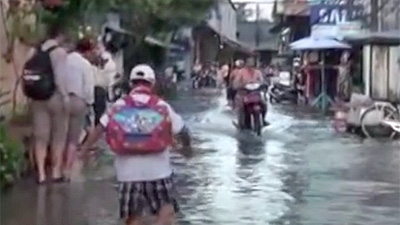For six months each year, the city of Can Tho in Vietnam floods – on average – twice a day. As water spills into houses and shops, business grinds to a halt and children pick their way through dangerously flooded streets to get to school.
During the past ten years, the floods have gotten worse, with maximum sea levels rising 8 – 10 inches. “The water stays up for about four hours each time,” says Cao Van Buon, a business owner.
As seasonal and extreme weather events become more severe, cities like Can Tho face an enormous challenge. Many of the world’s largest cities are located on coasts, deltas, or riverbanks; globally, 60 percent of the world’s cities are at risk from rising sea levels and storm surges. With this in mind, more than 400 mayors from around the world met at the UN’s Paris climate conference determined to take action.
“There was a clear signal from Paris that municipal leaders are not only deeply committed to making sure their cities adapt to the impacts of climate change, but are also leading the way to lower emissions through low-carbon development,” said Ede Ijjasz-Vasquez, Senior Director for the World Bank’s Social, Urban, Rural and Resilience Global Practice. “With COP21 behind us, it’s time to get on with the real work of the post-COP agenda.”
Last year, the World Bank provided over $3 billion in urban climate finance and technical assistance to help developing countries build climate-smart cities; this figure is expected to grow proportionately as the Bank moves to increase its climate finance by a third over the next five years.
As urban populations grow faster than ever – with 90 percent of that growth happening in developing countries – the World Bank and its partners are providing advice, tools, and funding to address the urban climate challenge. Here’s a look at what the Bank is doing:
Adaptation
Cities are particularly vulnerable to climate change, because that’s where people and assets are concentrated. The World Bank has helped cities understand and build resilience for more than a decade, promoting early warning systems, stronger infrastructure, flood management, and disaster preparedness programs. In Sri Lanka, World Bank loans are improving Colombo’s resilience and ability to prevent floods. In Bogota, Colombia, schools have been upgraded to meet resilient building codes and people living in high-risk areas susceptible to landslides and flash floods have resettled in safer territory.
“Adaptation is about managing risk,” said Niels B. Holm-Nielsen, Global Lead for Resilience and Disaster Risk Management at the World Bank. “There is a lot for cities to consider – improving water circulation to avoid flooding, territorial planning to guide more resilient urban growth and, most importantly, how to keep things going in the face of major storm or natural disaster.”
Among many tools offered by the World Bank is a new program called “City Strength,” which evaluates resilience on a holistic basis – looking at different sectors like transport, energy, health, waste management, and information and communications technology – bringing the findings together to identify critical gaps or areas of weakness.


